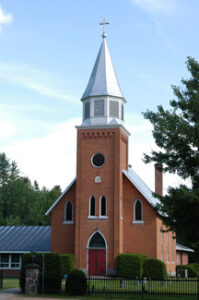
The earliest photograph of the current church, probably taken in the first decade of the 20th century. The small building to the left is the original log church, built in 1875
It did not take too long for the congregation to decide that their log church was not quite what they really wanted. Although completed in 1875, at a meeting on June 23, 1883, it was decided to build a new church as soon as the congregation felt able to undertake the task. A building committee, consisting of Gustav Michel, Oswald Hampel and Karl Gutzman was elected, with the task of bringing in an estimate for a new church building.
When the congregation decided, in April of 1896, to build a more substantial brick church, the architect and supervisor of choice was Bruno Michel, son of Gustav. The church, measuring 30 feet by 45 feet (9.1 meters by 13.7 meters) was completed the following year at a cost of $1,400.00.

Bruno and Bertha Michel
When the congregation decided, in April of 1896, to build a more substantial brick church, the architect and supervisor of choice was Bruno Michel, son of Gustav. The church, measuring 30 feet by 45 feet (9.1 meters by 13.7 meters) was completed the following year at a cost of $1,400.00.
The cornerstone was laid on May 9, 1897, an event recorded in a German newspaper of the time, the Kirchen Blat.” An original copy of the article was accidentally found in an old dresser inherited and partly dismantled in 1956. The article was forwarded to Mrs. J. Zilgalvis, a church member, who donated it to the archives of St. John’s. The aricle commences, “Incessantly and untiringly, the Germans in Petawawa have worked toward the erection of a new church, although this was associated with many troubles and expenses…”
A great deal of volunteer labour was required to build the church, with the bricks being hauled from below Pembroke by horse-drawn wagon. The three Michel sons (Bruno, Robert and Emil) donated a silver communion set to the church, which was inscribed with their names and which is still in use. The church was, in fact, completed and dedicated by October of 1897, and Bruno Michel and Bertha Leeder were the first couple to be married in the new church. Rudoph Hampel, who had worked very hard to complete the church by October 28th, married his fiancee, Miss Augusta Schwantz on that day. Their’s was the second marriage in the church.
The cornerstone was laid on May 9, 1897, an event recorded in a German newspaper of the time, the Kirchen Blat.” An original copy of the article was accidentally found in an old dresser inherited and partly dismantled in 1956. The article was forwarded to Mrs. J. Zilgalvis, a church member, who donated it to the archives of St. John’s. The aricle commences, “Incessantly and untiringly, the Germans in Petawawa have worked toward the erection of a new church, although this was associated with many troubles and expenses…”
A great deal of volunteer labour was required to build the church, with the bricks being hauled from below Pembroke by horse-drawn wagon. The three Michel sons (Bruno, Robert and Emil) donated a silver communion set to the church, which was inscribed with their names and which is still in use. The church was, in fact, completed and dedicated by October of 1897, and Bruno Michel and Bertha Leeder were the first couple to be married in the new church. Rudoph Hampel, who had worked very hard to complete the church by October 28th, married his fiancee, Miss Augusta Schwantz on that day. Their’s was the second marriage in the church.

St. John’s as it appears today